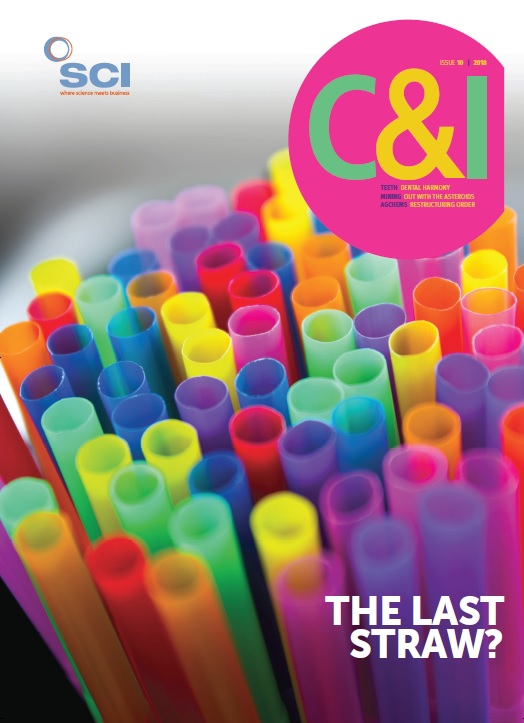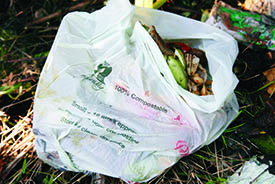Biodegradable polymers have a healthy future, with Europe set to lead the growth in demand, Maria Burke reports
‘Biodegradable plastics have become more cost-competitive with petroleum-based plastics and the demand is growing significantly, particularly in Western Europe, where environmental regulations are the strictest,’ says Marifaith Hackett, director of specialty chemicals research at analysts IHS Markit. The current market value of biodegradable plastics is set to exceed $1.1bn in 2018, but could reach $1.7bn by 2023, according to IHS Markit’s new report.
In 2018, the report finds that global demand for these polymers is 360,000t, but forecasts an average annual growth rate of 9% for the five years to 2023 – equivalent to a volume increase of more than 50%. Western Europe holds the largest share (55%) of the global market, followed by Asia, and Australia and New Zealand (25%), then North America (19%).
In another report released in May 2018, the US Plastics Industry Association (PLASTICS) was similarly optimistic, finding that the bioplastics sector (biodegradables made from biological substances) is at ‘a growth cycle stage’. It predicts the US sector will outpace the US economy as a whole by attracting new investments and entrants, while also bringing new products and manufacturing technologies to make bioplastics ‘more competitive and dynamic’.
As bioplastics product applications continue to expand, the dynamics of industry growth will continue to shift, the report notes. Presently, packaging is the largest market segment at 37%, followed by bottles at 32%. Changes in consumer behaviour are expected to be a significant driver.
‘Changes in US tax policy, particularly the full expensing of capital expenditure, should support R&D in bioplastics,’ says Perc Pineda, chief economist at PLASTICS. ‘The overall low cost of energy in the US complements nicely with R&D activities and manufacturing, which generates a stable supply of innovative bioplastic products.’ He points, for example, to efforts by companies and collaborations to develop and launch, at commercial scale, a 100% bio-based polyethylene terephthalate (PET) bottle as a case in point. Most PET bottles currently contain around 30% bio-based material.
The future of biodegradable polymers will be driven by environmental legislation, Hackett believes. ‘While the properties and processability of biodegradable polymers have improved, allowing their use in a broader range of applications, it is legislation that is the single most important demand driver,’ Hackett says.
‘Restrictions on the use of non-biodegradable plastic shopping bags in Italy and France have led to a significant increase in the consumption of biodegradable polymers in those countries, and we expect European countries will continue to lead in legislative restrictions.’
In countries where laws are less strict or non-existent, biodegradable polymer use has grown more slowly or stagnated, she continues. ‘Growing consumer awareness and activism regarding environmental issues could certainly increase the market for biodegradable plastics.’
In the US, while interest is growing, PLASTICS concludes there is continued need for education. A PLASTICS survey of US consumers in January 2018 found only 32% are ‘familiar’ with bioplastics, although this had risen from 27% in 2016. It also found that 64% of consumers would prefer to buy a product made with bioplastics, and expect to see bioplastics in disposable plastic tableware, plastic bags, food and cosmetic packaging, and toys. Despite the industry’s embrace of bioplastics and their expanding presence in a wide range of products, Pineda notes: ‘A high percentage of surveyed respondents believe they have not seen or used a product made from bioplastic - either bio-based or biodegradable. Continuing to educate consumers on bioplastics would go a long way.’
|
360,000t |
|
>100m t |
|
32% |
Despite all the optimism, the market for biodegradable polymers is still ‘a drop in the bucket’ when one compares it to demand for traditional plastics such as polyethylene (PE), says Hackett. According to IHS Markit, global demand for PE, the world’s most-used plastic, has nearly doubled during the last 20 years. IHS Markit expects 2018 global PE demand to exceed 100m t.
And not everyone is positive about biodegradable polymers. Richard McKinlay is head of circular economy at consultants AXION. ‘I see no reason to move away from conventional, recyclable rigid packaging such as PET, PP and HDPE. However, because the recycling of flexibles [like crisp packets and food pouches] can be very expensive, especially if there is a lot of residue that must be washed off, biodegradable polymers could have a good fit here. Otherwise, the substitution of other packaging or items such as straws is really not worthwhile, unless it can degrade fully in the marine environment, which is yet to be proven.’ He also points out there are concerns over emissions from biodegradable packaging. ‘If disposed of in a landfill, then non-degradable packaging will be inert, but if packaging degrades in an uncontrolled way and releases carbon dioxide or methane, then this is not a good thing.’
While there is a desire to do the right thing for the environment, there is also a lack of understanding of waste management infrastructure, McKinlay warns. ‘So there has been the growth of biodegradable polymers but without the necessary treatment options. There needs to be a more robust system in place before a switch to biodegradables is viable.’ Infrastructure is expensive, but there are composting facilities, so it’s a matter of getting the material to the right place. ‘This is for the waste managers to develop with input from brands and retailers. But there also needs to be sound reasoning behind composting over recycling – you can recycle a PET bottle many times, but with a degradable pack it really is only “single use” – and since the big problem is packaging not going to a controlled landfill/recycling route, biodegradables do not solve the issue of litter or marine plastics at all.’
Biodegradable material is often seen as a solution to both litter and marine litter, agrees British Plastics Federation (BPF) sustainability issues executive Helen Jordan, and mistakenly perceived as a ‘greener’ material choice. ‘However, the idea that the material will disappear in a short amount of time is incorrect and could have the unintended effect of increasing littering. We also lack high quality, conclusive research into how biodegradable material will behave in the marine environment, which can be very cold, dark and lacking in oxygen.’
BPF members are particularly concerned about biodegradable material ending up in the plastics recycling stream, says Jordan. This is because of the impact on end-markets for recycled plastics. ‘In industries such as construction, where long guarantees for products are needed, companies are extremely reluctant to use recycled material if they suspect it may contain biodegradable material. With wider scale use of biodegradable material, this could become more of an issue. Biodegradable material, if adopted, therefore needs to be only used in applications where there is no risk it will end up in the existing plastic recycling stream.’
There are currently not widespread collections for food waste, and current anaerobic digestion plants cannot accept biodegradable material, so new facilities would need to be developed in the UK, Jordan continues. There would also need to be a significant consumer education programme to ensure the public understand what can be recycled through conventional plastic recycling facilities and how to appropriately dispose of biodegradable material.
|
The terms biodegradable and compostable are often used interchangeably but they mean slightly different things. Biodegradable polymers break down with the help of naturally occurring microorganisms, such as bacteria and fungi, to form carbon dioxide and water, and examples include both petroleum- and biobased-plastics. A few of these polymers decompose in garden compost bins or in soil, freshwater, or saltwater, but usually they require industrial or municipal compost facilities. Biodegradation can take a very long time and depends on the temperature and the amount of moisture present, as well as the particular polymer chains present. Home compost rarely reaches the required temperature to break down most biodegradable polymers. That’s why the term ‘compostable’ means something slightly different: such a material degrades in a natural biological process to produce carbon dioxide, water, inorganic compounds and biomass, but normally within a year. In 2017, starch compounds and polylactic acid (PLA) accounted for 46% and 42%, respectively, of total biodegradable polymers consumption, according to a report by analysts IHS Markit. Most biodegradable polymers are found in food packaging, disposable tableware (cups, plates, and cutlery), plastic bags and compost bags. Other applications include foam packaging, which includes starch-based loose-fill packaging (packing peanuts), mulch films and other agricultural applications, paper coatings for cups and cartons, as well as textiles, nonwoven fabrics, resorbable medical devices such as sutures and implants, downhole tools for oil and gas field operations and 3D printing filament. The US accounts for the bulk of production for these polymers, but Thailand, with its proximity to growing markets in Southeast Asia, its expanding bio-economy, favourable investment climate, stable government, and access to cost-effective sugarcane feedstocks for fermentation, is becoming an increasingly important contributor to the biodegradable polymers market, the IHS Markit report says. Manufacturers of biodegradable polymers include NatureWorks – a joint venture of Cargill and PTT Global Chemical, Novamont, BASF, PTT MCC Biochem – a joint venture of PTT Public Company, the parent of PTT Global Chemical, and Mitsubishi Chemical Corporation. In addition, TOTAL Corbion PLA, a joint venture of energy producer TOTAL and lactic-acid producer Corbion, plans to start up a world-scale PLA facility in Thailand by the end of 2018. |
So to reap the benefits of biodegradable polymers, countries need to have the collection and composting infrastructure to support their use. According to Hackett, very few major cities or municipalities have the necessary infrastructure in place. Many biodegradable polymers are compostable only in special industrial composting facilities, which operate at higher temperatures than home compost piles. ‘Only a subset of biodegradable polymers is compostable in backyard compost bins; an even smaller subset is compostable in the soil or in marine environments,’ she explains.
The cost of establishing the infrastructure necessary to support collection and composting remains a barrier to growth. Mandatory composting programmes can help, partly by spurring demand for compostable waste bags and tableware (cups, plates and cutlery), both important end uses for biodegradable polymers. However, the shortage of composting facilities capable of processing biodegradable polymers limits the positive impact of mandatory composting programmes on biodegradable polymer demand.
Hackett admits that, despite the potential of biodegradable polymers, they are still mostly taking a backseat to other sustainability approaches, such as reducing plastics consumption and recycling. ‘For various reasons, which may include consumer confusion regarding bio-based plastics versus biodegradable polymers, there is not as much demand for these more sustainable plastics as you might expect, despite heightened public awareness of the plastics waste issue.’
Patrick Krieger is assistant director of regulatory & technical affairs at PLASTICS. ‘Like all plastics, the right polymer matches attributes with application. Every company has a unique set of sustainability goals, so it’s important that the right materials be paired with the right application in order to achieve those specific goals. Other approaches that promote sustainable and extended use of resources to reduce landfilling and littering, like recycling, may have a broader utility.’
Despite these caveats, with more European legislation, the industry could see major changes and pushback from producers of traditional plastic products, Hackett states. ‘The last time IHS Markit assessed the global demand for biodegradable polymers, we noted the US was the largest driver of demand growth for this segment, but due to legislation, Europe is by far the leading demand centre. Europe is the place to watch, as Europeans are particularly motivated to reduce marine litter.’


 Biodegradable and compostable
Biodegradable and compostable 


